
 |
|
#1
|
|||
|
|||
|
Hi, I wonder if I could ask for some advice :
I recently had a full set up done on one of my guitars. New Nut and saddle. By his own confession, he did not get the radius on the saddle correct and we are now on the second saddle and there is still a problem. 1. How should a luthier determine the radius ? I tend to measure my action by the height of the top and bottom E strings at the 12th fret, (using a Stewmac Guage) but the problem is D and G strings. (My preferred action is .080" treble and .100/105" on the bass). I ask for this action on all guitars regardless of scale and string gauge, but in this case it is a Collings 12c fret 25.5" scale on which I use EJ17s. 2. How should the action height at 12 for ALL strings be determined? Thanks in advance.
__________________
Silly Moustache, Just an old Limey acoustic guitarist, Dobrolist, mandolier and singer. I'm here to try to help and advise and I offer one to one lessons/meetings/mentoring via Zoom! |
|
#2
|
|||
|
|||
|
I think your choice of height is perfect for an acoustic guitar if we are referring to understring height, I encourage people to have 80/100 at the 12th, you also need to know how much relief is dialed in as well as that will affect the 12th fret height.
I always set saddle radius as the same as the fretboard, the difference between the arc that the strings follow with this radius and the actual fretboard is so small, to me it’s inconsequential. The only time I modify my saddle radius from the same as the fretboard is when dealing with electric guitars that have a fender radius of 7 1/4, these choke when you try to do bends above the 12th, so I up the height of the saddle at e/b/g. But, back to your question, the a/d/g/b strings don’t get measured height wise in my setups, they simply fall where the replicated radius puts them Steve
__________________
Cole Clark Fat Lady Gretsch Electromatic Martin CEO7 Maton Messiah Taylor 814CE |
|
#3
|
|||
|
|||
|
Quote:
__________________
---- Ned Milburn NSDCC Master Artisan Dartmouth, Nova Scotia |
|
#4
|
|||
|
|||
|
I never think about the radius...at all. See answer to #2. Also check Bryan Kimsey's setup section.
http://www.bryankimsey.com/setup/ Quote:
Let's take your setup at 0.105" and 0.080". The difference between those is 0.025" so each should be 0.005" different than the adjacent string. You end up with... E 0.080" B 0.085" G 0.090" D 0.095" A 0.100" E 0.105" |
|
#5
|
|||
|
|||
|
Very helpful thread.
Todd - thanks for the information on this. I'll need it when I get around to setting up that little vintage guitar I just bought. |
|
#6
|
|||
|
|||
|
I do essentially the same thing as you describe.
The method matters less than the result. There are various methods that will produce the desired result. For the OP, I'd suggest you measure the height of the intermediary strings on one of your guitars that is setup to your liking and provide the heights of each string to the luthier/repair person doing the work. Let him or her figure out how to achieve that result. |
|
#7
|
|||
|
|||
|
Quote:
|
|
#8
|
|||
|
|||
|
I do the same.
|
|
#9
|
|||
|
|||
|
I wrote a program to calculate string clearances at each fret for a given fixed fretboard radius, scale length, nut width, bridge width, and bridge radius.
For a 25" scale length and 12" radius fb, the ideal bridge radius would be 12.6". This assumes perfectly radiused frets and doesn't account for differences in string vibration patterns. Raising the 1st and 6th string action by 1 mil at the 12th fret (and proportionally smaller amounts for the inner strings) has the same effect. These differences are so small that you can ignore them and proceed as recommended by previous posters. |
|
#10
|
|||
|
|||
|
Some photos of how I do it, if you want the inbetween steps, I can pm you the link
Steve Raw blank 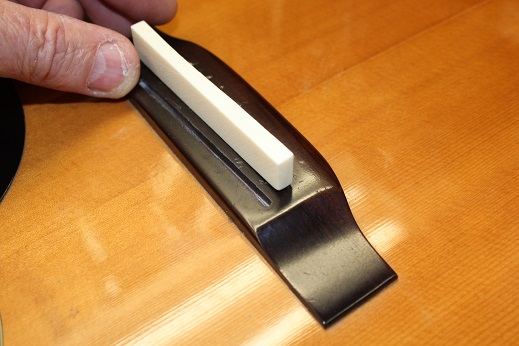 Fitted blank 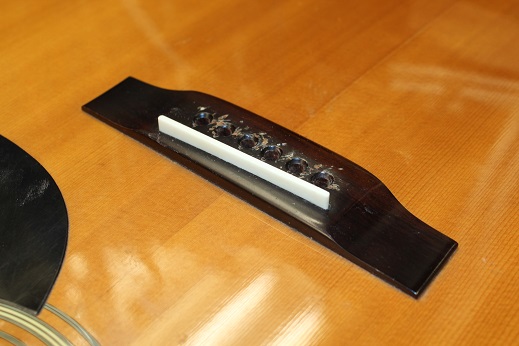 Referenced fretboard 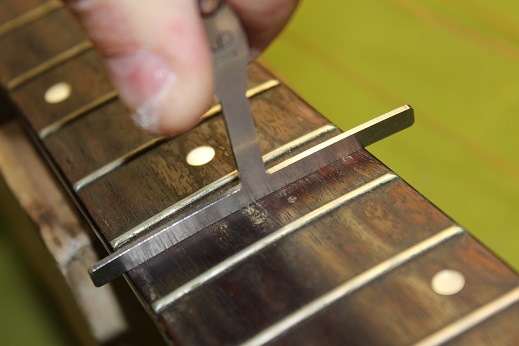 Shaped caul duplicating radius to saddle 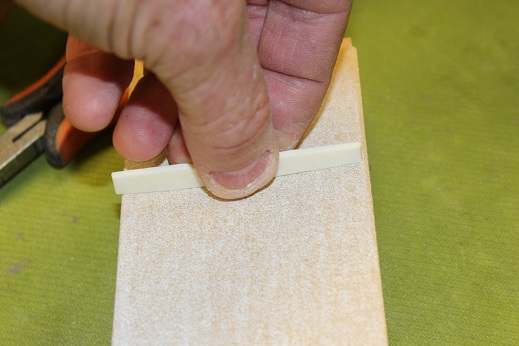 Refitted 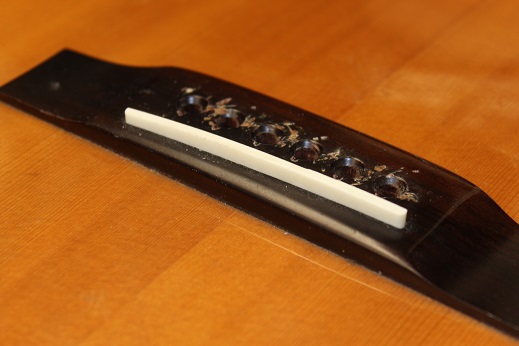 Intonated top, fretboard radius retained, action height set vee bottom sanding of the saddle 
__________________
Cole Clark Fat Lady Gretsch Electromatic Martin CEO7 Maton Messiah Taylor 814CE |